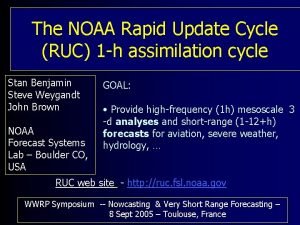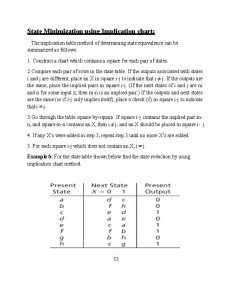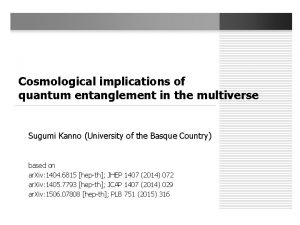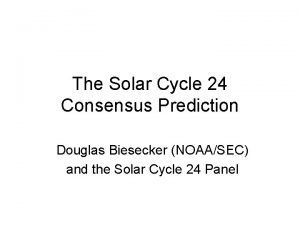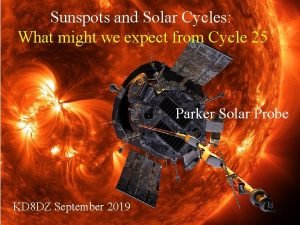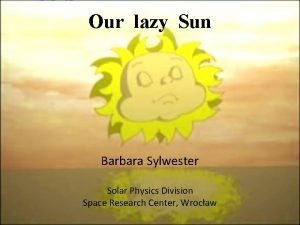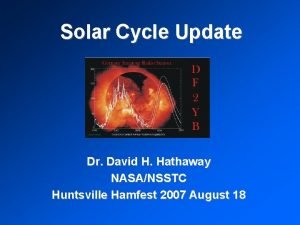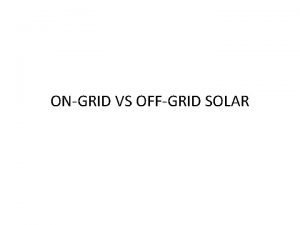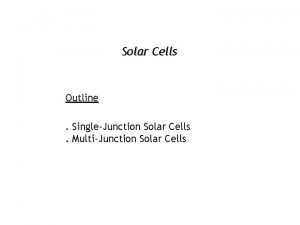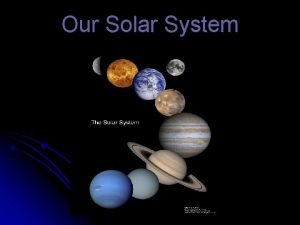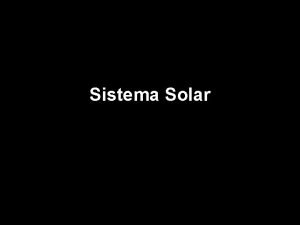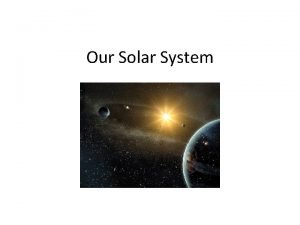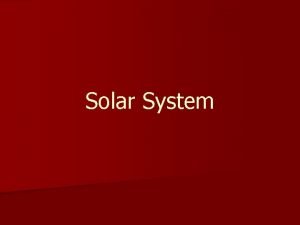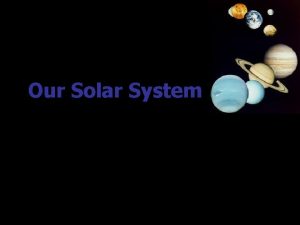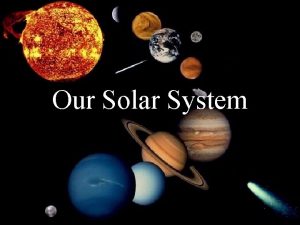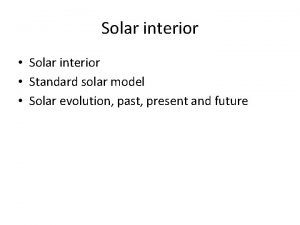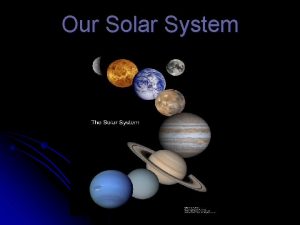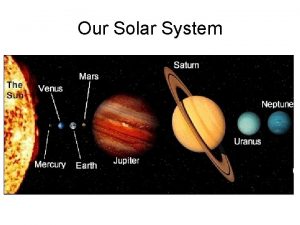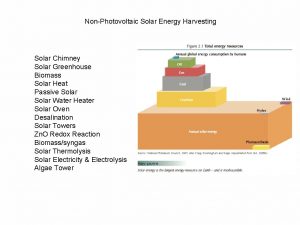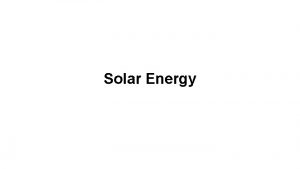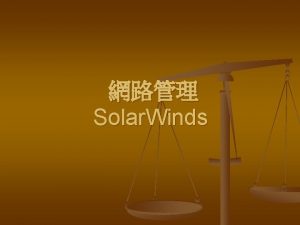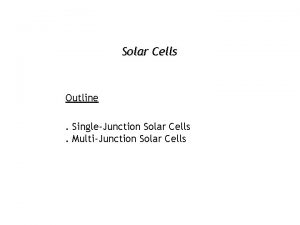Solar Cycle Update with Implications for HAMs David
















































- Slides: 48

Solar Cycle Update with Implications for HAMs David H. Hathaway NASA MSFC Space Science Office 2012 August 18 Huntsville Hamfest

Outline • • • The Sun and Solar Activity The Sun and the Ionosphere The Solar Cycle The Sun’s Magnetic Dynamo Solar Cycle Predictions

The Sun and Solar Activity

The Sun Radius = 109 REarth Mass = 333, 000 MEarth Surface Temp = 9, 930 °F Surface Density = Air/5000 Core Temp = 28 million °F Core Density = Gold × 8 Composition: 70% H 28 % He 2% (C, N, O…)

Sunspots are dark (and cooler) regions on the surface of the Sun. They have a darker inner region (the Umbra) surrounded by a lighter ring (the Penumbra). Sunspots usually appear in groups that form over hours or days and last for days or weeks. The earliest sunspot observations indicated that the Sun rotates once in about 27 days.

Sunspot Structure Sunspots are regions where intense magnetic fields break through the surface of the Sun. The magnetic field strengths are typically about 6000 times stronger than the Earth’s magnetic field. Magnetic fields and the ionized gases within the Sun are intimately tied together. Where magnetic pressure dominates – the gas follows the magnetic field. Where gas pressure dominates – the magnetic field follows the gas. In sunspots the magnetic pressure dominates – this inhibits the convective transport of heat and makes sunspots cooler.

Solar Magnetism – The Key

Explosive Events • Solar flares – 10 -1000 X excess in X-rays and Extreme Ultraviolet (EUV) • Coronal Mass Ejections (CMEs) – magnetic clouds blasted off the Sun • Solar Energetic Particles – relativistic particles from flares and CMEs

CME Impact on Earth Magnetized clouds of plasma blasted off of the Sun as CMEs can impact the Earth’s environment – distorting the magnetic field surrounding the Earth and producing energetic particles that stream into the Earth’s atmosphere to create aurorae.

Space Weather Space weather refers to conditions on the Sun and in the space environment that can influence the performance and reliability of space-borne and ground-based technological systems, and can endanger human life or health.

The Sun and the Ionosphere

The Basics Extreme Ultraviolet (EUV) and X-rays from the Sun ionize the gases in the Earth’s upper atmosphere. At night the ions and electrons recombine at the denser lower altitudes (the D and E layer) where collisions are more frequent. The D layer disappears at night. The E layer (or patches of the E layer) can survive the night if the solar EUV is strong. Solar EUV varies with the sunspot cycle – strong at max. 304 Å

The Solar Spectrum Solar ultraviolet light (UV) is energetic enough to dissociate O 2 molecules and form O 3 (ozone) in the stratosphere. It takes Extreme Ultraviolet (EUV and XUV) to ionize atoms and molecules in the ionosphere. N 2 -> N 2+ + e- for λ < 80 nm O -> O+ + e- for λ < 91 nm Ly α O 2 -> O 2+ + e- for λ < 103 nm NO -> NO+ + e- for λ < 134 nm EUV produces the F-region XUV (+ Ly β) produces the E-region X-rays (+ Ly α) produce the D-Region Ly β = 102. 6 nm, Ly α = 121. 6 nm The solar spectrum from X-rays to Microwaves

Energetic Particles Energetic particles, mainly electrons and protons, stream into the ionosphere and contribute to ionization – particularly at high latitudes where aurorae are seen. 1 -30 ke. V electrons – E-Layer >30 ke. V electrons – D-Layer >1 Mev protons – D-Layer

NOAA GOES SWx Monitors NOAA has monitored both the Solar X-ray flux (1 -8 Å = 0. 1 -0. 8 nm) and energetic particles in Geostationary orbits since 1975. This is important for the D-region and radio wave absorption. But we haven’t monitored the EUV and XUV which are important for the FRegion. We’ve used proxies like Sunspot Number or 10. 7 cm radio Flux.

TIMED SEE The Solar EUV Experiment (SEE) on the NASA Thermosphere Ionosphere Mesosphere Energetics and Dynamics (TIMED) mission was designed to fill in this “EUV Hole”. TIMED was launched in 2002 and is still operating. Wavelength coverage by Mission EUV Spectrum 2002 -2004

Solar Dynamics Observatory Until now! SDO was launched on February 11, 2010 into a Geosynchronous Orbit that keeps the satellite in constant contact with the ground station at White Sands, New Mexico. SDO has three sets of instruments: AIA – Atmospheric Imaging Array HMI – Helioseismic and Magnetic Imager EVE – Extreme ultraviolet Variability Experiment

EVE on SDO The Extreme-ultraviolet Variability Experiment (EVE) on SDO has four instruments for accurately measuring changes in solar EUV: MEGS-A – spectrograph covering 5 -37 nm MEGS-B – spectrograph covering 35 -105 nm ESP – a spectrophotometer with 4 wavelength bands (20, 25, 30, 37 nm) SAM – a pinhole camera that monitors X-rays (0. 1 -7 nm)

AIA on SDO The Atmospheric Imaging Assembly on SDO has four telescopes with filters that provide 10 different (16 Megapixel) images at a cadence of one every 12 seconds. Latest images at: http: //sdo. gsfc. nasa. gov/data/

A Prominence Eruption An example of what the Sun does in the EUV (He 304Å).

MUF and TEC The Maximum Usable Frequency (MUF) for radio waves reflected off of the ionosphere is directly related to the Total Electron Content (TEC) of the ionosphere. The TEC depends upon both the solar EUV and Xray irradiance and geomagnetic activity. We now have direct observations of solar EUV/X-ray emissions – no need for proxies!

The Solar Cycle

Sunspot Cycle Discovery Astronomers had been observing sunspots for over 230 years before Heinrich Schwabe, an amateur astronomer in Dessau, Germany, discovered in 1844 that the number of sunspot groups and the number of days without sunspots increased and decreased in cycles of about 10 -years. Schwabe’s data for 1826 to 1843 Number of Sunspot Groups per Year Number of Spotless Days

23 Full Cycles Shortly after Schawbe discovery Rudolf Wolf proposed using a “Relative” Sunspot Number count. While there were many days without observations prior to 1849, sunspots have been counted on every day since. To this day we continue to use Wolf’s Relative Sunspot Number and his cycle numbering. The average cycle lasts about 11 years, but with a range from 9 to 14. The average amplitude is about 100, but with a range from 50 to 200.

Sunspot Latitudes Sunspots appear in two bands on either side of the equator. These bands drift toward the equator as the cycle progresses. Big cycles have wider bands that extend to higher latitudes. Cycles overlap by 2 -3 years.

Hale’s Magnetic Polarity Law In 1919 Hale (along with Ellerman, Nicholson, and Joy) found that the magnetic field in sunspots followed a definite law, “Hale’s Law” such that: “…the preceding and following spots … are of opposite polarity, and that the corresponding spots of such groups in the Northern and Southern hemispheres are also opposite in sign. Furthermore, the spots of the present cycle are opposite in polarity to those of the last cycle”.

Active Region Tilt- Joy’s Law In that same 1919 paper Joy noted that sunspot groups are tilted with the leading spots closer to the equator than the following spots. This tilt increases with latitude.

Three Solar Cycles in 3 D In addition to these magnetic polarity changes and the equatorward drift of the sunspot latitudes, there are important flows on the surface and within the Sun: Differential Rotation – faster at the equator, slower near the poles; and Meridional Flow – flow from the equator toward the poles along the surface.

Polar Field Reversals In 1959 Babcock noted that the magnetic polarities of the Sun’s weak polar fields also reverse from one cycle to the next, and that this reversal happens at about the time of sunspot cycle maximum.

The Sun’s Magnetic Dynamo

Babcock’s Dynamo (1961) Dynamo models have been developed to explain the sunspot cycle. a) Dipolar field at cycle minimum threads through a shallow layer below the surface. b) Differential rotation shears out this poloidal field to produce a strong toroidal field (first at the mid-latitudes then progressively lower latitudes). c) Buoyant fields erupt through the photosphere giving Hale’s polarity law and Joy’s Law. d) Meridional flow away from the active latitudes gives cancellation near the poles and equator.

Leighton et al. (1962) A year later, Leighton, Noyes, & Simon Astrophys. J. 135, 474 (1962) reported on their discovery of supergranules - a cellular pattern of horizontal flows covering the solar surface with typical cell diameters ~30 Mm, lifetimes ~1 day, and flow velocities of 300 m/s. The Doppler velocity pattern due to supergranules

Supergranule Diffusion Supergranules carry magnetic elements to their boundaries in a diffusion-like random walk.

Measuring Solar Flows Hathaway & Rightmire (Science 327, 1350, 2010; Ap. J 729, 80, 2011) cross-correlated the features in strips from 60, 000 magnetic maps of the Sun obtained at a 96 -minute cadence from 1996 to 2011 to determine the axisymmetric flow components for each solar rotation.

Average Flow Profiles Our MDI data included corrections for CCD misalignment, image offset, and a 150 year old error in the inclination of the ecliptic to the Sun’s equator. We extracted differential rotation and meridional flow profiles from over 60, 000 image pairs from May of 1996 to September of 2010. Average (1996 -2010) differential rotation profile with 2σ error limits. Average (1996 -2010) meridional flow profile with 2σ error limits.

Solar Cycle Variations in the Axisymmetric Flows While the differential rotation does vary slightly over the solar cycle, it is the meridional flow that shows the most significant variation. The Meridional Flow slowed from 1996 to 2001 but then increased in speed again after maximum. The slowing of the meridional flow at maximum seems to be a regular solar cycle occurrence (Komm, Howard, & Harvey, 1993). The greater speed up after maximum is specific to Cycle 23. Differential rotation variations Meridional flow variations

Characterizing Supergranules Hathaway et al. Ap. J 725, 1082 (2010) analyzed and simulated Doppler velocity data from MDI to determine the characteristics of supergranulation. These cellular flows have a broad spectrum characterized by a peak in power at wavelengths of about 35 Mm. MDI SIM

Synchronic Map Construction These simulated vector velocities can be use in the construction of Synchronic maps – instantaneous maps of the entire solar surface. In the simulation shown below (for the year 2001) newly observed data is assimilated in the moving window but the magnetic field is transported everywhere by the evolving and moving supergranules.

2001 South Pole Reversal

Solar Cycle Predictions

Early Predictions The Sun’s polar fields are the seeds of the next solar cycle in most dynamo models. This is confirmed by direct observations of the last three cycles and by geomagnetic activity for the last 12 cycles. Cycle 24 should be small – max ~70.

Three Years Ago Small cycle predicted based on Polar Fields and Geomagnetism

Two Years Ago Including recent activity indicated an even smaller cycle.

Last Year A small upward correction.

This Year In spite of a flurry of activity late last year, the prediction dropped slightly – still indicating the smallest cycle in 100 years.

The Heliophysics Armada To be joined by the Radiation Belt Storm Probes next Thursday

Conclusions • Solar activity impacts modern technology • Solar EUV/XUV emissions and magnetic disturbances control the ionosphere • We are making progress in understanding the Solar Cycle • Cycle 24 will peak in mid-2013. • Cycle 24 will be the smallest cycle in 100 years.

http: //solarscience. msfc. nasa. gov/
 Recovery techniques based on immediate update
Recovery techniques based on immediate update Sferocytosis
Sferocytosis Hams com
Hams com Alcohol harm reduction worksheets
Alcohol harm reduction worksheets Hams alcohol taper
Hams alcohol taper Handi hams
Handi hams Wholesale solar power
Wholesale solar power What is an inexhaustible source of energy
What is an inexhaustible source of energy Replace
Replace Implications of database approach
Implications of database approach Social constructivist meaning
Social constructivist meaning Implication table method
Implication table method Nursing implications for synthroid
Nursing implications for synthroid Multiplicity of evidence
Multiplicity of evidence How audience negotiate meaning in mil
How audience negotiate meaning in mil Marketing implications
Marketing implications Tautological implication
Tautological implication Mathmatical proposition
Mathmatical proposition 5 educational implications of philosophy
5 educational implications of philosophy Consumer behavior cengage
Consumer behavior cengage Nursing implications
Nursing implications Bandura social learning theory 1971
Bandura social learning theory 1971 Legal implications of social media
Legal implications of social media Implications of nativist theory
Implications of nativist theory Language
Language Implikasi etis dari teknologi informasi
Implikasi etis dari teknologi informasi Learning curve in physical education
Learning curve in physical education 3002001030
3002001030 Social implications of computers
Social implications of computers Legal implications of nursing documentation
Legal implications of nursing documentation Ranexa nursing implications
Ranexa nursing implications Humalog nursing implications
Humalog nursing implications S-r bond theory
S-r bond theory Discussion and implications
Discussion and implications Guided participation examples
Guided participation examples Medical implications of developmental biology
Medical implications of developmental biology What is legal implications
What is legal implications Nietzsche on existentialism
Nietzsche on existentialism Legal implications in nursing practice
Legal implications in nursing practice Dromotropic
Dromotropic Legal implications of nursing documentation
Legal implications of nursing documentation Future implications definition
Future implications definition Examples of decongestants
Examples of decongestants Mechanism of antifungal drugs
Mechanism of antifungal drugs Solar radiation has a part in the water cycle by
Solar radiation has a part in the water cycle by Solar cycle 25 prediction
Solar cycle 25 prediction Solar cycle 25
Solar cycle 25 Solar cycle
Solar cycle Kontinuitetshantering
Kontinuitetshantering








